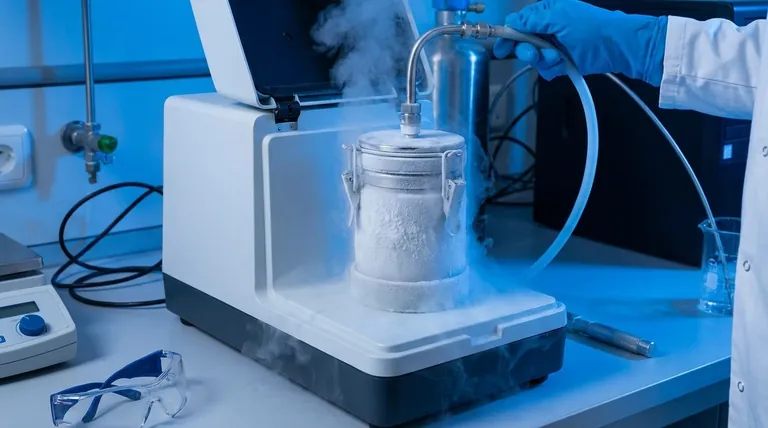In essence, a cryo-mill is a specialized laboratory ball mill that uses extreme cold to solve grinding problems. It features an integrated cooling system that continuously bathes a sealed grinding jar with liquid nitrogen, both before and during the milling process. This cryogenic grinding makes tough, elastic samples brittle and preserves volatile components that would otherwise be lost to heat.
The core function of a cryo-mill isn't just to grind, but to first fundamentally change a material's properties with extreme cold. By making a sample brittle, it enables effective size reduction where traditional milling methods would fail or damage the sample.

The Core Problem: Why Standard Milling Fails
Many materials are notoriously difficult to process at room temperature. Standard milling methods, which rely on mechanical force alone, often fall short for two primary reasons: heat and elasticity.
The Elasticity Challenge
Materials like plastics, polymers, and many biological tissues are tough and elastic. When struck by a grinding ball at room temperature, they tend to deform or tear rather than shatter. This results in an inefficient, inconsistent grind and can generate significant heat.
The Volatility and Heat-Sensitivity Problem
The friction generated during standard milling creates heat. This heat can cause volatile components—such as flavors, fragrances, or specific chemicals—to evaporate from the sample. For heat-sensitive materials like certain proteins or pharmaceuticals, this can lead to degradation and alter the sample's fundamental structure.
How Cryogenic Grinding Solves the Problem
A cryo-mill overcomes these challenges by using the power of extreme cold, typically from liquid nitrogen at -196°C (-321°F).
The Principle of Embrittlement
The primary mechanism is embrittlement. By cooling a material far below its glass transition temperature, its molecular structure changes. It loses its rubbery, elastic properties and becomes hard and glass-like.
The Grinding Mechanism
Once the sample is brittle, the internal mechanics of the ball mill become highly effective. The grinding balls can easily impact and shatter the frozen material into a fine, uniform powder. The continuous cooling ensures the sample remains brittle throughout the entire process.
Preserving Sample Integrity
Because the entire grinding process occurs at extremely low temperatures, the heat generated by friction is instantly neutralized. This locks volatile components in place and protects heat-sensitive structures from degradation, ensuring the resulting powder is a true representation of the original sample.
Understanding the Trade-offs
While incredibly effective, cryo-milling is a specialized technique with unique requirements.
The Need for Liquid Nitrogen
The most significant consideration is the requirement for a steady supply of liquid nitrogen. This is a consumable resource that introduces logistical, cost, and safety factors. Proper handling, including the use of cryogenic gloves and safety glasses, is mandatory.
Sample and Batch Size
Cryo-mills are typically laboratory-scale instruments. They are designed for preparing relatively small samples, not for large-scale industrial production.
Not a Universal Solution
While it excels with tough or volatile materials, it may be unnecessary or even counterproductive for simple, brittle samples like minerals or ceramics, where a standard mill would be more efficient.
When to Choose a Cryo-Mill
Your decision to use a cryo-mill should be driven by the specific properties of your sample and your analytical goals.
- If your primary focus is grinding tough polymers, plastics, or rubber: A cryo-mill is essential to induce embrittlement for effective size reduction.
- If your primary focus is preserving volatile organic compounds (VOCs): The cryogenic process is non-negotiable for preventing the loss of these key components during analysis.
- If your primary focus is analyzing heat-sensitive biological samples: Cryo-milling protects the integrity of DNA, RNA, and proteins during homogenization.
Ultimately, a cryo-mill empowers you to prepare difficult samples with a precision and integrity that room-temperature methods simply cannot achieve.
Summary Table:
| Aspect | Standard Milling | Cryogenic Milling |
|---|---|---|
| Temperature | Room Temperature | Extremely Low (-196°C) |
| Sample Type | Hard, Brittle Materials | Tough, Elastic, Heat-Sensitive Materials |
| Key Mechanism | Mechanical Force | Embrittlement + Mechanical Force |
| Volatile Preservation | Poor (Heat Loss) | Excellent (Cold Preservation) |
| Ideal For | Minerals, Ceramics | Polymers, Plastics, Biological Samples, Pharmaceuticals |
Ready to achieve precise, contamination-free sample preparation? KINTEK's cryo-mills are engineered to handle your most challenging materials—from tough polymers to heat-sensitive biologics—ensuring sample integrity and accurate results. Let our experts help you select the right cryogenic grinding solution for your laboratory. Contact KINTEK today to learn more!
Visual Guide

Related Products
- Benchtop Laboratory Freeze Dryer for Lab Use
- High-Energy Omnidirectional Planetary Ball Mill Milling Machine for Laboratory
- Laboratory Horizontal Planetary Ball Mill Milling Machine
- Benchtop Laboratory Vacuum Freeze Dryer
- High Energy Planetary Ball Mill Milling Machine for Laboratory
People Also Ask
- What are the main steps involved in the freeze-drying process? A Guide to the 3 Key Stages
- What types of liquid samples can be processed using a laboratory freeze dryer? Preserve Your Sensitive Materials
- What role do laboratory freeze dryers play in the food industry? Unlock Superior Food Preservation
- Why are laboratory freeze dryers considered economical tools? Maximize Value and Minimize Loss
- What is the freeze drying or lyophilisation process? A Guide to Gentle, High-Quality Dehydration



















